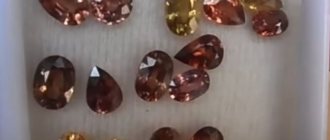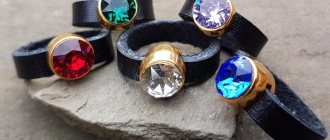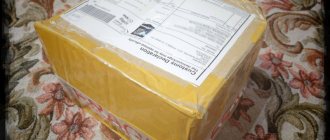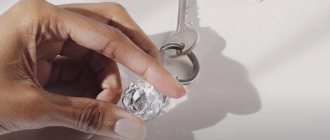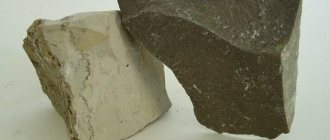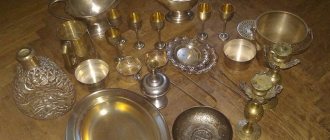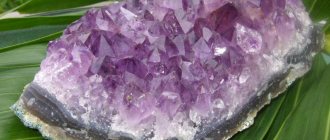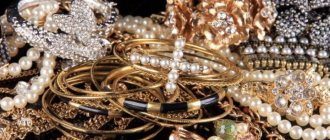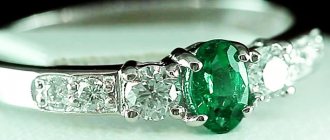October 18, 2021
The difference between cubic zirconia and Swarovski crystal is one of the most popular topics of discussion among fans of inexpensive jewelry imitations. Both stones have earned unquestioned authority, although they are synthesized by somewhat similar laboratory methods. Artificially grown gems have even come to be called “diamonds of the future” - they are so good at transmitting the refraction of light when properly polished and intricately cut.
Let's look at the general points, how cubic zirconia differs from Swarovski, what unique properties each type of crystal has, and whether it is possible to distinguish them at home.
What are Swarovski stones
Swarovski crystals do not have valuable physical, chemical properties or natural energy. Stones only have aesthetic value.
Gems are considered an imitation of diamonds, an alternative that wins in price. They are made from cheap material with characteristics almost identical to glass.
The gems are processed using electric current, making the edges appear immaculately smooth. Rainbow highlights and refraction of light occur due to foil coating of the crystal faces.
Swarovski stones are characterized by:
- the predominance of lead and barium in the chemical composition (based on lead crystal);
- high refractive index;
- varied color palette;
- standard forms;
- precision in cutting (14–16 unequal faces);
- mirror coating.
Types of stones
Swarovski crystals represent all kinds of stones in different shapes and colors. Gems are produced under special brands and lines. The main ones:
- Swarovski rhinestones in the form of tiny jewelry-cut crystals, decorating clothes, furniture, and interior items;
- Swarovski crystal beads, often presented in the form of faceted drops in various colors;
- Swarovski pearls with a perfect matte finish, gracefully shimmering mother-of-pearl;
- adhesive cold-fix rhinestones used in manicure and hot-fix thermal rhinestones for clothing;
- cubic zirconia with high refractive indices, hardness and dispersion;
- Swarovski topaz, created from a natural mineral by proprietary cutting.
Each variety can have any shade, because almost all stones are synthesized using an artificial method.
To view the photo gallery:
Suit with Swarovski crystals
Swarovski crystal
Swarovski beads
Swarovski pearls
Swarovski adhesive rhinestones
Swarovski cubic zirconias
Swarovski Topazes
To watch a video about crystals:
Why are Swarovski crystals so expensive?
The history of the Swarovski company began in Austria in the 19th century, when its founder Daniel first used an electric machine to cut the famous Bohemian crystal. In addition to the cutting method, the main know-how was the material - glass with a high lead content, which improves shine. A mirror coating was also applied to the rhinestones, resulting in a cheap imitation of a diamond.
Brooch with Swarovski crystals
The Swarovski brand approached its current popularity in the middle of the 20th century: rhinestones, due to their unusual shine, became popular in jewelry and clothing design; famous fashion designers began to use them - Coco Chanel, Christian Dior and others.
In the 70s, cubic zirconia was invented, a much more successful substitute for diamond than rhinestones (by the way, how cubic zirconia differs from zircon can be found in this article). Of course, the Swarovski company did not miss the opportunity and applied high cutting technologies to this material.
All jewelers know that the concept of “European machine cut” implies high precision in cutting a stone, an ideal match between different stones from the same batch. But not everyone knows that the word “European” appeared precisely thanks to Swarovski (many years ago they began using special automatic machines for cutting cubic zirconia), and cutting itself has long been done in China, Thailand and other Asian countries.
Laser engraving on Swarovski cut cubic zirconia
Each cubic zirconia, even the smallest one, is engraved by Swarovski, confirming the quality of the stone. It doesn't make the shine any better, but it's a great marketing ploy.
What is included in the concept of “Swarovski crystals” at the moment? These are traditional rhinestones for jewelry and clothing, machine-cut jewelry inserts made from synthetic and natural stones. Natural stones are mainly colorless topaz with a multi-colored coating, and synthetic stones are cubic zirconia and nanoglass (sital) of different colors, which differ from ordinary glass in better shine and play of light. By the way, nanotals were invented in Russia, just like cubic zirconia.
Let's finally try to answer the main question - why are “crystals” made from glass and inexpensive stones so valued? Mainly, of course, because of the value and history of the brand - marketing has always been the company's strength. But the product offered is of high quality, perhaps the best on the market. Is it worth paying extra for the brand, or is it better to look for less famous stones of similar quality? It’s up to you to decide.
PS fun fact: in addition to producing rhinestones and jewelry inserts for the mass market, Swarovski produces binoculars and optical sights. They are also very high quality and expensive, but perhaps not as overrated as “crystals”.
History of the jewelry house
The history of the company begins with a man named Daniel Swarovski. The inventive young man was a dreamer and knew how to bring his plans to life. He wanted to make diamonds accessible to everyone and developed a technology for producing crystals that were equally beautiful but cheaper.
It all started with a factory in the North of the Czech Republic. Daniel worked for his father, learning and gaining experience. A little later, he moved to Paris to acquire the necessary engineering skills and acquire qualifications.
When he turned 21, the young man visited Vienna at the Edison and Siemens exhibition. The technological progress reflected in the exhibits inspired Swarovski to make his own invention.
Already in 1892, Daniel registered the first patent. He invented the first glass processing machine. Cutting has become automated, which has increased production speed and reduced consumed resources.
In 1895, the engineer founded the first factory in Tyrol, an Australian region. Today, the company's branches are spread all over the world, and crystals are always popular.
Watch the radio broadcast on the history of the brand:
Swarovski crystals. Why are they unique and why are they so expensive?
In jewelry stores, you have often noticed sparkling items with Swarovski crystals. They were immediately surprised at the price. After all, these are not precious or even semi-precious stones, but... glass. Where does this price come from? Just because of the brand?
No, not only. We'll tell you why jewelry with Swarovski stones continues to be highly valued around the world.
Rich brand history
The company's founder, Daniel Swarovski, was born in Bohemia, the birthplace of Bohemian glass or, as it is also called, Czech crystal. Daniel sincerely admired the properties of crystal and thought about how to improve the beauty of the material. In 1892, the talented Daniel invented the world's first electric cutting machine. The new product has created a real technological revolution! The machine could finely cut even small crystals - the result was perfect sharp edges that sparkled no worse than diamonds. In 1895, production moved to Austria (this year is considered the founding date of the company). Since then, the company has continued to increase its momentum. Forbes magazine called Swarovski “the Austrian Rockefellers”, they became so rich.
Incredible technology
Initially, Daniel Swarovski cut only crystal, but later crystals were added to it, the unique raw materials for which were produced in the strictest confidence.
Swarovski is constantly improving its technology. Today, rhinestones consist of more than 70 components that are strictly classified. It is this composition, and not just the perfect cutting technology, that creates a unique diamond shine.
By the way, since 2012, Swarovski has stopped using toxic lead oxide in its products - rhinestones are environmentally friendly.
In addition to the famous crystals and rhinestones, Swarovski produces high-precision optical instruments, grinding equipment, chandeliers, jewelry, decorative figurines, bags, glasses and other accessories, and also engages in cutting precious and synthetic stones.
Trendsetters
In 1956, Manfred Swarovski patented the production of colored crystals. During these same years, Swarovski began collaborating with Dior and other fashion houses.
Remember Marilyn Monroe's famous sparkling transparent dress that she wore to Kennedy's birthday party? The spectacular outfit was embroidered with 6 thousand Swarovski crystals!
Then legendary stage costumes were created for Michael Jackson, Whitney Houston and Tina Turner.
Now Swarovski's portfolio includes more than 80 colors and 30 different effects, countless sizes and types of cuts. Rhinestones imitate metals and pearls, iridescent tints and create color effects.
Rich history, high technology, and incredible brilliance make jewelry with Swarovski crystals real works of art, be it jewelry with a scattering of stones or with one large stone in the center.
Legendary Swarovski crystals - on ourgold.ru
What are Swarovski crystals made from?
The basis of Swarovski crystals is lead crystal. Its chemical composition is close to the structure of rock crystal. There are several ways to produce synthesized stones:
- The primary material is melted and placed in special conditions so that the melt can crystallize. Later it is divided into individual gems. Most often, the method is used in the manufacture of cubic zirconia.
- Cooling of a special solution, on which crystals later begin to grow.
- Imitation of natural conditions under which gemstones are formed. Exposure of the material to high temperatures and significant pressure. The most common method in creating simulated diamonds, cubic zirconia.
After production, the gems are sent for processing, where they acquire their special optical properties. The treatment is carried out using current. After this, a special silver coating is applied to each edge.
Uniqueness and advantages of stones
Swarovski crystals, thanks to their signature cut, are close to diamonds in optical properties. Certain types of stones have higher refractive indices and light dispersion, which makes the crystals shimmer brighter. They can have any shades depending on the impurities in the composition of the gems.
The advantages of gems include:
- pure dazzling shine;
- uniform even tone;
- classic shapes;
- smooth, even edges (14 edges with alternating thicknesses), corners match perfectly;
- spray resistance;
- affordable price.
But in contrast, there are some disadvantages:
- not particularly durable;
- Most often they are used to make costume jewelry; they are rarely set in precious metals.
Swarovski's innovative developments have made it possible to produce crystals at affordable prices, but similar in appearance to diamonds.
Thanks to developed technologies, gems are produced in unlimited quantities without harming nature or wasting resources.
What came first: cubic zirconia or Swarovski? Production technology
Daniel Swarovski, the founding father of the legendary brand, began to actively reform the world of jewelry in 1889, when at the World Exhibition in Paris his company presented the first ever cutting machine powered by electricity. True, she only polished blanks made of rock crystal, which later became rhinestones.
Cubic zirconia is the brainchild of Soviet scientists who, in 1970, managed to synthesize zirconium dioxide into a crystalline body that is as close as possible to diamond in its properties. Even the name of the substance is an abbreviation for the Physics Institute of the Academy of Sciences, in whose laboratories discoveries are still being made that change the understanding of artificially grown stones.
A little later, the Swarovski brand launched the production of its cubic zirconia, which in Europe was labeled “cubic zirconium” due to the molecular structure of the crystal. They differ in composition from Soviet and Russian ones - the addition of lead slightly changes the spectrum of light refraction, the stones literally shine with a rainbow reflection even in low light.
Important: To avoid confusion, the manufacturer has separated ordinary glass rhinestones from more expensive imitations into subsidiary brands. Thus, the first include inlays produced under the Swarovski Crystal brand; they are much cheaper and are used in premium jewelry. But the branded analogue of our cubic zirconia in the West is known as Swarovski Zirconia - they are inserted exclusively into jewelry made of gold and silver.
How to distinguish Swarovski crystals from fakes
The high demand for crystals has provoked the appearance of counterfeits on the shelves. To create them, they use the cheapest equipment and lower quality materials. You can distinguish a fake by the following signs:
- Packaging with a hologram and company logo. The factory version contains the main information about the crystals: article number, quantity, color. Small stones are contained in a single package, large stones are contained in plastic cells.
- Branded laser engraving.
- The country of origin must be listed as Australia.
- The cut of a genuine crystal includes at least 14 facets. The sides are smooth, without flaws or microcracks.
- The reverse side of the gems is silver in color. This color enhances the shine of the crystals.
- Real crystals have an even tone, completely homogeneous. Cloudiness, scratches, stains are typical only for fakes.
- Swarovski crystals are not strung on a thread. There are no such decorations.
- Although the gems are made from inexpensive materials, the price for them will not be too low. If they try to sell you stones that are suspiciously cheap, it’s a fake.
Buy jewelry with Swarovski crystals only in specialized jewelry stores.
When purchasing, ask for a certificate confirming the authenticity of the stone.
To watch a video review about comparing rhinestones from other manufacturers:
Swarovski stones: what they are made of and how to distinguish them from fakes
The famous brand "Swarovski" is a company that produces artificial gems. It cannot be said that the stones have high jewelry value. However, crystals are famous for their impressive radiance and beauty. This is due to the fact that during the production process the stones are carefully cut. As a result, each crystal has brilliance and an internal play of light, which allows them to be compared to precious minerals. What are Swarovski stones made of? And is it possible to somehow distinguish them from fakes? Let's figure it out together.
Imitations of real diamonds, as well as an excellent alternative to many precious stones, are Swarovski stones. What are these beautiful creatures made of? It turns out that Swarovski products are based on a completely inexpensive material, similar to ordinary glass. However, further stages of processing give such beauty to crystals.
Learn more about the material and process of creating Swarovski stones
Lead crystal is the basis of the famous stones. Its chemical composition is similar to rock crystal. How are Swarovski stones different? Of course, with its brilliance, which hundreds of workers achieve by growing popular crystals in three ways:
- Melting of primary material. Placing it under certain conditions so that the melt crystallizes. Afterwards, the crystallized material is separated into individual gems;
- Cooling of a special solution. Using it as a base on which crystals later begin to grow;
- Imitation of natural conditions. This allows gems to be grown under the influence of high temperatures, as well as high pressure.
Next comes the processing process. It is he who gives the crystals special optical properties. Each stone is treated with electric current, and then a silver coating is applied to its surface.
Finished gems are treated with electric current. This allows you to achieve perfectly smooth edges. Foil coating (silver coating) gives each stone iridescent highlights and the property of light refraction.
If you know how much Swarovski stones cost (price for 1 crystal), you might think that these “jewels” are not such at all. Although in fact, jewelry made from them turns out to be very attractive and does not look very cheap.
Jewelry lovers value Swarovski stones very much. What kind of stones are these, the cost of which is so low?! It turns out there are even cheaper options! We are talking about a fake.
How to distinguish Swarovski stones from fakes
The huge demand for crystals has given rise to the emergence of illegal manufacturers who are trying to create exactly the same stones with all their properties and characteristics, but for a minimal budget. “Fraudsters” use the cheapest equipment and low-quality materials, obtaining similar stones, only at a low cost.
You can distinguish a fake if you know the following signs of real stones:
- Packaging with hologram. Availability of a company logo. The factory version has all the main information about the stones: article number, quantity, color. Small pebbles are packed in a single package, while larger ones are contained in plastic cells;
- Laser engraving;
- The country of origin is always Austria;
- Swarovski stones cannot have less than 14 facets. Each side is smooth and has no microcracks;
- On the reverse side the stone will have a silvery tint. This enhances the shine of the crystals;
- Real stones do not come with cloudiness, uneven tone or other errors.
To be 100% sure of the authenticity of the stones you purchase, you need to make purchases exclusively in specialized stores and always ask for a certificate for the product.
The use of shining stones
Most often, gems are used in the beauty industry, for making jewelry, clothing decor, and interior elements. They are used in the production of souvenirs: pens, boxes or figurines.
To attach the stones yourself, no special skills are required: they are attached to glue using available tools (tweezers, toothpicks). You only need to be careful and patient so that everything turns out smoothly and beautifully.
Expensive figurines
The company launched a series of signature crystal figurines in 1976. The figures shimmer and shine no worse than miniature crystals in jewelry. There are people around the world who track new items and buy them for their collection. About 0.5 million people belong to an action figure collecting club.
The most expensive and valuable among collectors are:
- A 5" x 7" Hello Kitty figurine released in a limited edition in 2013.
- Donald Duck figurine, limited to 150 pieces and priced at $9,000.
- Exclusive Bald Eagle with yellow topaz beak. The body is made of amber, covered with yellow amber Swarovski crystals.
For the centenary of the Swarovski company in 1995, a museum was opened in Innsbruck. All the best works are collected there. The museum itself is located in a cave.
View this post on Instagram
Posted by SWAROVSKI (@swarovski) Jun 29, 2022 at 7:59 am PDT
View this post on Instagram
Posted by SWAROVSKI (@swarovski) Jun 28, 2022 at 5:12 PDT
Accessories
Stones are used to decorate accessories. From bags and shoes to watches, cufflinks, phones, wallets. Gems are attached to stylized items using special glue. They create a feeling of luxury and make things look more expensive.
Gems can be used in handmade. Fixation technology does not require special knowledge and skills. Therefore, you can independently attach them to any surface, decorating various accessories and fabrics.
View this post on Instagram
Posted by SWAROVSKI (@swarovski) Jun 10, 2022 at 9:35 am PDT
View this post on Instagram
Posted by SWAROVSKI (@swarovski) Jun 11, 2022 at 1:06 am PDT
Cloth
Rhinestones are used by designers in creating fashionable outfits and stylized images.
They decorate evening dresses and festive outfits. It is not uncommon to see crystals in stage costumes. Swarovski crystals in clothes look impressive and catchy.
Swarovski rhinestones help create an original and vibrant look. The sparkling stones framing the dress will make its owner the center of attention.
View this post on Instagram
Posted by SWAROVSKI (@swarovski) May 13, 2022 at 6:12 am PDT
View this post on Instagram
Posted by SWAROVSKI (@swarovski) May 6, 2022 at 5:45 PDT
Nails
Today, crystals are actively used in manicure art. Tiny rhinestones are attached to nails, creating intricate designs and patterns featuring shiny crystals. Stylists create real masterpieces on the nail plates of their clients.
Rhinestones are fixed under the influence of temperature. At the bottom of the crystals there is an adhesive base, through which you just need to warm it up and apply the rhinestone to the desired place.
See what the rhinestones for this art look like:
Jewelry with Swarovski crystals
Swarovski crystals are especially often used in the manufacture of jewelry. They are rarely set in precious metals and are more often used to create costume jewelry.
Sometimes there are gilded jewelry coated with a layer of silver. In this case, the gems look brighter and more refined.
The stones resemble diamonds, so they look expensive and luxurious. Suitable for formal style, evening outings.
You should not wear jewelry with business suits. Gems are suitable for informal holiday gatherings.
Most often, gems are encrusted with:
- brooches;
- pendants;
- bracelets;
- rings;
- earrings;
- men's jewelry;
- cufflinks;
- tie pins.
View this post on Instagram
Posted by SWAROVSKI (@swarovski) Jul 25, 2022 at 9:45 am PDT
View this post on Instagram
Posted by SWAROVSKI (@swarovski) Jul 25, 2022 at 12:17 pm PDT
Features of crystal care
Jewelry is not durable. They are susceptible to external factors and fragile. Therefore, you need to follow some rules in caring for gems:
- Do not use abrasives when cleaning stones. To avoid damaging the mirror coating, use a soap solution and soft brushes or cloth. Wear rubber gloves when handling large stones to avoid leaving marks.
- Periodically polish the stone with soft cloths or cotton cloth.
- Avoid contact with water, household chemicals, cosmetics, and perfumes on the surface of stones.
- Store in a separate bag from other stones to avoid scratching the gems.
Swarovski crystals: instructions for use
The crystal composition, developed by Daniel Swarovski, has been refined and improved over the years. The formula of the crystals is still kept in the strictest confidence. According to some reports, it includes more than 70 elements. In addition, the unique shine of stones is achieved using special cutting, polishing and coating techniques.
Crystals can be of different shapes, but always have 14 sides. This creates a special play of light that makes the stones shine so brightly. In addition, each crystal has a silver substrate in the form of sputtering. It is needed so that the light beam does not scatter. It is not surprising that unique stones have become a symbol of luxury and decorate a variety of products.
For those who are planning to become the owner of things with Swarovski crystals or are just thinking about it, it is useful to know:
Where are Swarovski crystals used?
Accessories are the main area of application for crystals. And it has long been no longer limited to jewelry: stones are also inlaid into jewelry. So, in 2022, Penelope Cruz, together with Swarovski, created not the first collection of gold jewelry with her favorite crystals.
Where else are Swarovski stones used:
- On designer clothes and shoes. Moreover, the choice is not limited to elegant haute couture dresses. Thus, the American brand Juicy Couture has released a collection of sportswear decorated with Swarovski crystals. It includes overalls, sweatshirts, jackets, trousers, tops and shorts. Nike recently unveiled sneakers covered in crystals.
- On luxury gifts. For the wedding of the British Prince William and Kate Middleton, the German company Bling My Thing presented the newlyweds with a Mini Cooper car, hand-decorated with 300 thousand Swarovski crystals. It may be impractical, but it is a beautiful gesture towards the recipient.
- In home decor. In the official stores of the chain, anyone can purchase glasses, a box or a candlestick with Swarovski.
- In makeup and manicure. Crystals are used to decorate the upper or lower eyelid to create a vibrant look. They create original nail designs.
- Any accessories are encrusted with rhinestones - from watches to ballpoint pens and smartphone cases.
Pencils inlaid with Swarovski stones: Piqsels
Rules of care
Jewelry with genuine Swarovski stones does not come cheap. To extend their life, follow a few recommendations:
- Minimize contact of stones with water, household chemicals, cosmetics and perfumes. Before cleaning, washing dishes or taking a shower, it is better to remove accessories from Swarovski.
- Friction against hard surfaces can damage the crystal. Store your jewelry in a soft fabric case.
- Wipe them regularly with a soft cloth. Then the stones will retain their unique shine.
- To clean jewelry, dip it in warm soapy water without soaking. Wipe with a soft, lint-free cloth.
In the era of conscious consumption, Swarovski crystals take on a special meaning. Costume jewelry with them has become an affordable alternative to precious jewelry, and the variety of shapes and colors allows everyone to choose their ideal accessory.
Original article: https://www.nur.kz/family/beauty/1897847-cto-takoe-kristally-svarovski-iv-cem-ix-osobennost/
Cost of jewelry
The price of jewelry is determined by the size and number of stones, the absence or presence of gilding, and silver plating. Average prices for products:
- bracelets from 3,000 to 10,000 rubles;
- necklaces and pendants from 2000 to 5000 rubles;
- rings from 2000 to 10,000 rubles;
- earrings about 5000 rubles.
Swarovski crystals are high-quality imitation diamonds. They will help diversify your style, make it more refined and attractive.
What do you think about Swarovski crystals? Share your opinion in the comments and repost the article on social networks.
